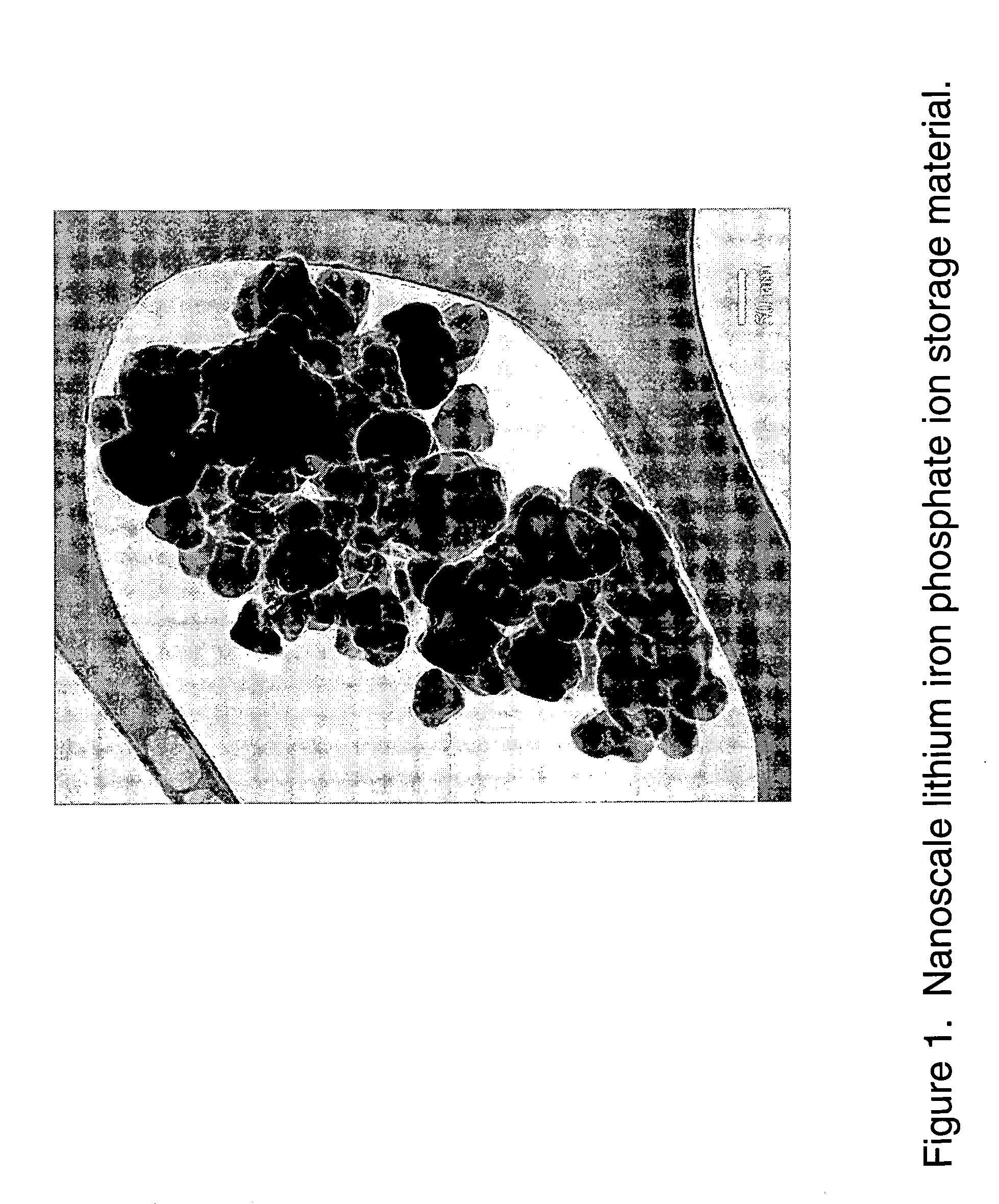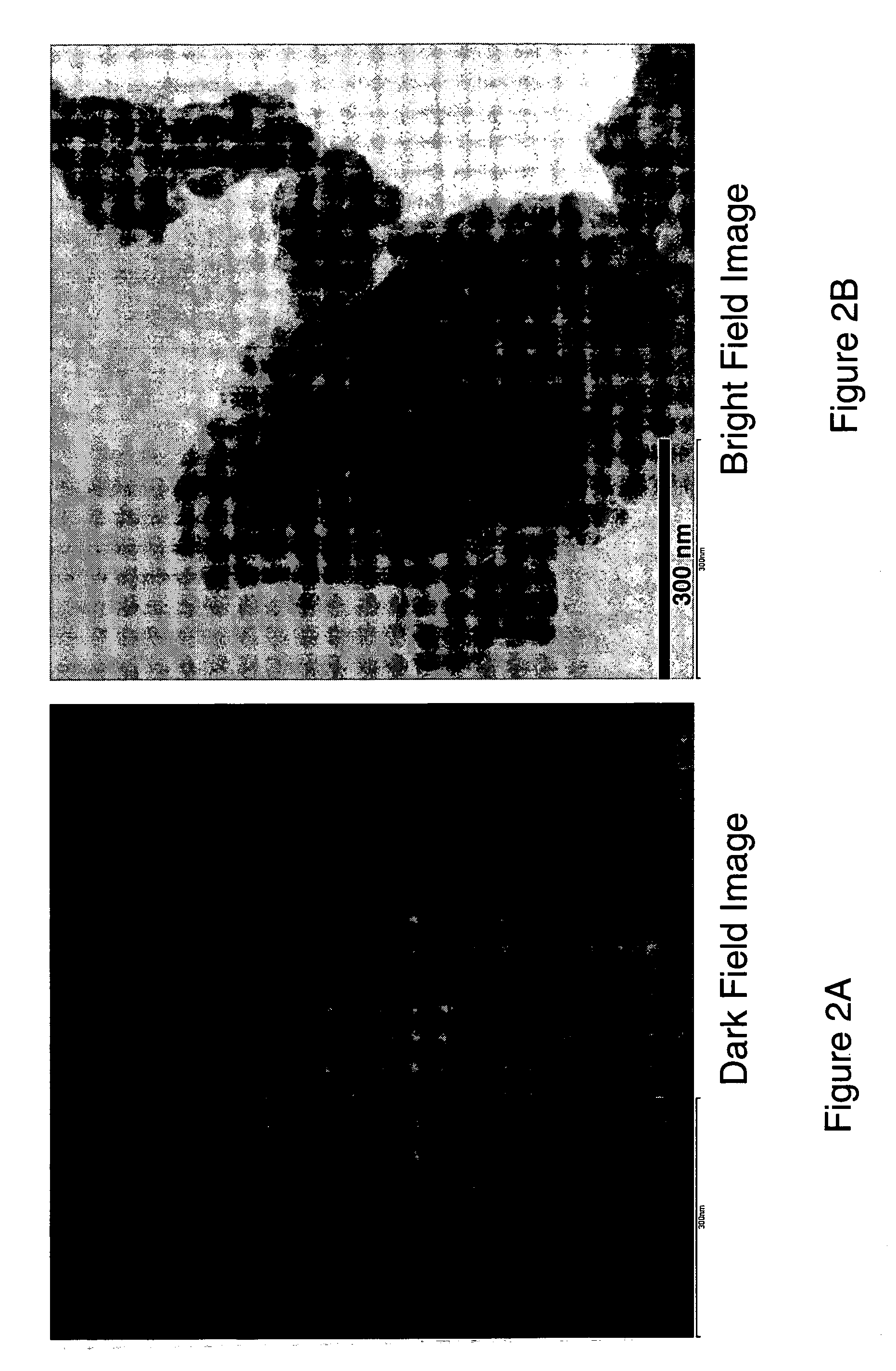Nanoscale ion storage materials
a technology of nano-scale ion storage and ion storage, which is applied in the direction of cell components, sustainable manufacturing/processing, and final product manufacturing, etc., can solve the problems of low electronic conductivity and alkali ion conductivity, and many such compounds exhibit limited solid solution range, so as to improve electromechanical stability, increase the intercalation rate, and improve the effect of electronic conductivity
- Summary
- Abstract
- Description
- Claims
- Application Information
AI Technical Summary
Benefits of technology
Problems solved by technology
Method used
Image
Examples
example 1
[0116] Lithium iron phosphate of overall composition LiFePO4 was prepared using the following proportions of starting materials:
Li2CO3 (Alfa-Aesar, 99.999%)0.739 gIron (II) oxalate (Alfa-Aesar, 99.999%)3.598 gAmmonium phosphate (Aldrich, 99.998%)2.301 g
[0117] While these basic components are known as starting materials for the synthesis of conventional LiFePO4, here through the use of a high purity acetone as the solvent (reagent grade, J. T. Baker), and using extended mixing to allow the starting components to undergo a gas-evolving mechanochemical reaction, a precursor is obtained that upon firing yields a low carbon, very high specific surface area nanoscale phosphate. The dry components were weighed and mixed with a sufficient quantity of high purity acetone to create a free-flowing suspension, and the mixture was roller-milled in a sealed polypropylene jar using zirconia milling media for 24 hours, obtaining a homogeneous and finely-divided precursor suspension. The precursor...
example 2
[0119] A nanoscale ion storage material having overall composition Li0.99FePO4 was synthesized and tested following procedures as described in Example 1, except that a larger batch size was made and different sources of starting materials were used. The composition was made using the following proportions of starting materials:
Li2CO3 (SQM) 7.4337 gIron (II) oxalate (Elementis)36.2696 gAmmonium phosphate (Heico)22.5541 g
[0120] A larger sealed polypropylene container, and steel milling media were used to mill the starting materials for 72 hours. Firing of the dried powder was conducted in nitrogen of 99.999% purity, and the final firing condition was 700° C. for 5 h. This powder was measured by the BET method to have a specific surface area of 45.4 m2 / g, corresponding to an equivalent spherical particle diameter of 36.7 nm. Combustion analysis showed that it had a residual carbon concentration of about 3 wt %. FIG. 5 shows test results from electrodes and lithium half-cells construc...
example 3
[0121] Nanoscale ion storage materials having overall compositions LiFePO4 and Li0.95FePO4 were synthesized and tested following procedures as described in Example 2, with the mass of lithium carbonate being adjusted so as to achieve the specified overall compositions. The LiFePO4 and Li0.95FePO4 powders were measured by the BET method to have a specific surface areas of 39.78 m2 / g and 46.2 m2 / g respectively, corresponding to equivalent spherical particle diameters of 41.9 nm and 36.1 nm respectively. Combustion analysis showed the two powders to both have residual carbon concentrations of 2.3 wt % and 3 wt % respectively. FIGS. 7 and 8 show the C / 50 charge and discharge curves for these two samples compared to a commercially purchased carbon-coated LiFePO4 from Aldrich Chemical Company of several micrometer average particle size and markedly inferior rate capability. Due to the very high rate capability of these materials, see FIG. 19, these low-rate charge / discharge curves show th...
PUM
 Login to View More
Login to View More Abstract
Description
Claims
Application Information
 Login to View More
Login to View More - R&D
- Intellectual Property
- Life Sciences
- Materials
- Tech Scout
- Unparalleled Data Quality
- Higher Quality Content
- 60% Fewer Hallucinations
Browse by: Latest US Patents, China's latest patents, Technical Efficacy Thesaurus, Application Domain, Technology Topic, Popular Technical Reports.
© 2025 PatSnap. All rights reserved.Legal|Privacy policy|Modern Slavery Act Transparency Statement|Sitemap|About US| Contact US: help@patsnap.com



